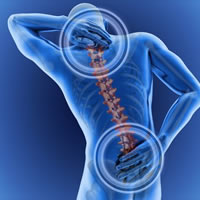Nucleoplasty for the treatment of herniated discs

Summary
The nucleoplasty or radiofrequency coblation, is a minimally invasive percutaneous technique of discal descompression that constitutes an alternative in the treatment for pain caused by discal hernia. It can be made in an ambulatory way or with hospital ingress and it requires anaesthetic sedation and/or local anaesthetic depending of each patient.
What is the nucleoplasty?
The nucleoplasty consists in the application of a low voltage and high frequency electric current called radiofrequency in the nucleus pulposus of the affected disc through the introduction of some special needles by whose inside cross one electrode. The electric current generates heat that cauterizes the inner disc parts reducing their size and the hernia´s size. Thanks to that, the pressure the hernia applies on the compressed nerve gets reduced, reducing pain.
How is it performed?
Nucleoplasty gets performed through taps in the skin at the surgery with the patient controlled by X Ray Technology. Patient requires local anaesthetic, what allows them to answer the doctor about the location of their pain. Nucleoplasty treatment lasts around an hour and it doesn´t become a painful process, patients usually feel a light discomfort.
One of its advantages is that it doesn´t require hospitalization, being the patients able to restart their activity practically immediately and it doesn´t require any kind of post-operative care.
Application cases
 Nucleoplasty is specially recommended in cases of cervical or lumbar hernias in people with young discs in which the production mechanism is traumatic, with high intradiscal pressure.
Nucleoplasty is specially recommended in cases of cervical or lumbar hernias in people with young discs in which the production mechanism is traumatic, with high intradiscal pressure.
Patients with contained disc herniation symptoms, who did not respond to other types of treatment and whose unique alternative is a bigger surgery can also benefit from this minimally invasive technique.
Nucleoplasty is not an appropiate procedure in cases of fracture or vertebral tumours, discal extrusion, annulus fibrosus disruption or vertebral stenosis and vertebral stenosis.
Benefits
- No surgery needed.
- No hospitalization needed.
- Life quality improvement thanks to pain relief.
- It helps to localize the pain zone precisely.
Possible risks
- Temporary pain increase.
- Medicines reactions, such as sudden heat or rash.
- Infection at the injection place.
- Hematoma, if accidentally there´s any damaged blood vessel
- Nerves damage at the injection place.


